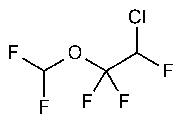Enflurane
Ethane,2-chloro-1-(difluoromethoxy)-1,1,2-trifluoro-,(±)-.
(±)-2-Chloro-1,1,2-trifluoroethyl difluoromethyl ether [13838-16-9].
»Enflurane contains not less than 99.9percent and not more than 100.0percent of C3H2ClF5O.
Packaging and storage—
Preserve in tight,light-resistant containers,and avoid exposure to excessive heat.
Identification—
The IRabsorption spectrum of a thin film of it exhibits maxima only at the same wavelengths as that of a similar preparation of USP Enflurane RS.
Specific gravity á841ñ:
not less than 1.516and not more than 1.519.
Refractive index á831ñ:
not less than 1.3020and not more than 1.3038at 20 .
.
Acidity or alkalinity—
Shake 20mLwith 20mLof carbon dioxide-free water for 3minutes,and allow the layers to separate:the aqueous layer requires not more than 0.10mLof 0.010Nsodium hydroxide or not more than 0.60mLof 0.010Nhydrochloric acid for neutralization,bromocresol purple TSbeing used as the indicator.
Water,Method Iá921ñ:
not more than 0.14%.
Limit of nonvolatile residue—
Allow 10.0mLto evaporate at room temperature in a tared evaporating dish,and dry the residue at 50 for 2hours:the weight of the residue does not exceed 2mg.
for 2hours:the weight of the residue does not exceed 2mg.
Chloride á221ñ—
Shake 25mLwith 25mLof water for 5minutes,and allow the liquids to separate completely.Draw off the water layer,and add to it 1drop of nitric acid and 5drops of silver nitrate TS:any turbidity produced is no greater than that produced in a solution containing 0.35mLof 0.020Nhydrochloric acid.
Limit of fluoride ions—
[NOTE—Use plasticware throughout this test.]
pH5.25buffer—
Dissolve 110g of sodium chloride and 1g of sodium citrate in 700mLof water in a 2000-mLvolumetric flask.Cautiously add 150g of sodium hydroxide,and dissolve with shaking.Cool to room temperature,and,while stirring,cautiously add 450mLof glacial acetic acid to the cooled solution.Cool,add 600mLof isopropyl alcohol,dilute with water to volume,and mix:the pHof this solution is between 5.0and 5.5.
Standard stock solution—
Transfer 221mg of sodium fluoride,previously dried at 150 for 4hours,to a 100-mLvolumetric flask,add about 20mLof water,and mix to dissolve.Add 1.0mLof sodium hydroxide solution (1in 2500),dilute with water to volume,and mix.Each mLof this solution contains 1mg of fluoride ions.Store in a tightly closed,plastic container.
for 4hours,to a 100-mLvolumetric flask,add about 20mLof water,and mix to dissolve.Add 1.0mLof sodium hydroxide solution (1in 2500),dilute with water to volume,and mix.Each mLof this solution contains 1mg of fluoride ions.Store in a tightly closed,plastic container.
Standard solutions—
Dilute portions of the Standard stock solutionquantitatively and stepwise with pH5.25bufferto obtain 100-mLsolutions having concentrations of 1,3,5,and 10µg per mL.
Test solution—
Shake 25mLwith 25mLof water for 5minutes,and allow the liquids to separate completely.Transfer 5.0mLof the water layer to a 10-mLvolumetric flask,dilute with pH5.25bufferto volume,and mix.
Procedure—
Concomitantly measure the potential (see Titrimetry á541ñ),in mV,of the Standard solutionsand the Test solution,with a pHmeter capable of a minimum reproducibility of ±0.2mV,equipped with a glass-sleeved calomel-fluoride specific-ion electrode system.[NOTE—When taking measurements,immerse the electrodes in the solution which has been transferred to a 150-mLbeaker containing a polytef-coated stirring bar.Allow to stir on a magnetic stirrer having an insulated top until equilibrium is attained (1to 2minutes),and record the potential.Rinse and dry the electrodes between measurements,taking care to avoid damaging the crystal of the specific-ion electrode.]Plot the logarithm of the fluoride-ion concentrations,in µg per mL,of the Standard solutionsversus potential,in mV.From the measured potential of the Test solutionand the standard curve,determine the concentration,in µg per mL,of fluoride ions in the Test solution:not more than 10µg per mLis found.
Assay—
Inject a volume of Enflurane of suitable size,but not more than 30µL,into a suitable gas chromatograph (see Gas ChromatographyunderChromatography á621ñ)equipped with a thermal conductivity detector.Under typical conditions,the instrument contains a 4-mm ×3-m stainless steel column packed with 20%liquid phase G4on 60-to 80-mesh S1A,the column is temperature-programmed at about 6 per minute from 60
per minute from 60 to 125
to 125 ,and the injection port temperature is maintained at about 200
,and the injection port temperature is maintained at about 200 .Dry helium is used as the carrier gas at a flow rate of about 60mLper minute.Calculate the percentage purity by dividing 100times the area under the Enflurane peak by the sum of all of the areas in the chromatogram.
.Dry helium is used as the carrier gas at a flow rate of about 60mLper minute.Calculate the percentage purity by dividing 100times the area under the Enflurane peak by the sum of all of the areas in the chromatogram.
Auxiliary Information—
Staff Liaison:Karen A Russo,Ph.D.,Scientist
Expert Committee:(PA1)Pharmaceutical Analysis 1
USP28–NF23Page 735
Phone Number:1-301-816-8379
